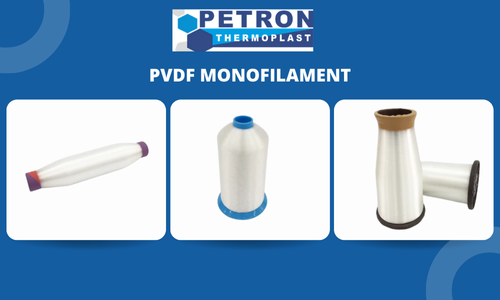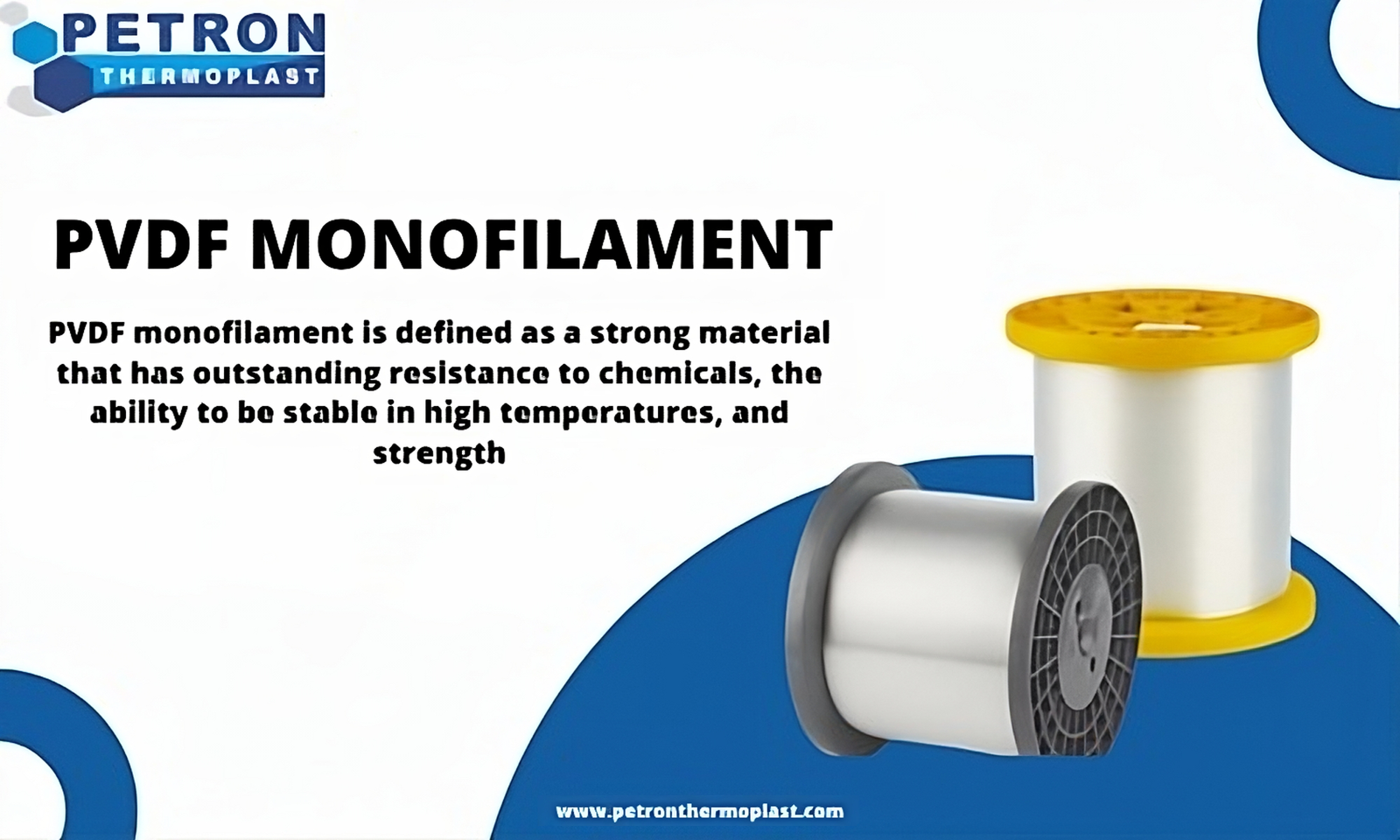Table of Contents
TogglePVDF Monofilament in Modern Industry 4.0
For the growth of modern industry, advanced materials are revolutionizing manufacturing processes and increasing product application activities. Among these materials, PVDF, or polyvinylidene fluoride monofilament, plays a tremendous role just because of its exceptional properties and versatility.
PVDF Monofilament
PVDF monofilament is described as a form of artificial thread that is created from PVDF (polyvinylidene fluoride). PVDF is a very unreactive and pure type of thermoplastic fluoropolymer. So that PVDF monofilament is defined as a strong material that has outstanding resistance to chemicals, the ability to be stable in high temperatures, and strength. These qualities make PVDF monofilament a perfect option for a wide range of industrial uses.
What is PVDF?
PVDF is known as polyvinylidene fluoride, and it is a type of thermoplastic fluoropolymer material. Thermoplastic fluoropolymer is simply a non-reactive plastic material that is specially designed
For modern industrialists. In today’s advanced and digitalized world, industrialization demands a certainty of purity, long-term durability, and resistance to solvents, acids, bases, and temperature. To attain the wide range of fruitful results and all the expectations in industrial-based areas, PVDF is recognized as the best option for this range of challenging uses and variety of demanding applications.
In simple terms, we can say that, capturing the demand for flexible materials that contain the ability to resist chemicals, go through temperature, maintain strength, and ensure cleanliness in technical progress and industry areas, PVDF is the only solution to maintain the quality and demands of all the expectations. PVDF is a flexible, growing material that demands an increase in higher technical and industrial areas like chemical production, water purification, electronics, medical device creation, and construction. Nowadays, for the success of industrial agreements, PVDF is recognized as the most important material to ensure quality as well as quantity.
Key Properties of PVDF
Chemical stability
PVDF is an ideal material to resist a wider range of chemicals, such as acids, organic solvents, and bases. It can maintain its stability even in harsh chemical environments.
Heat Stability
At a wide temperature range, even from -60°C to +150°C, materials like PVDF can maintain their properties without any harm or degradation.
Natural Strength
PVDF contains excellent mechanical properties, including high flexible strength, toughness, and resistance to polishing and force.
UV Resistance
PVDF is suitable for outdoor applications where direct sunlight is most common; it can tolerate excellent resistance to ultraviolet (UV) radiation.
Low Density
PVDF is reliable for low-weight applications as it is relatively lightweight compared to other fluoropolymers.
Electrical Insulation
It is good for various electronic components and wiring as it has dielectric properties.
Purity
PVDF is an idol for the semiconductor and pharmaceutical industries.
Manufacturing and Industrialization Uses of PVDF
Filtration Systems
The chemical resistance and purity of PVDF make it suitable for membranes and filter housings in applications such as water treatment and pharmaceuticals.
Pipes and tubing
PVDF is an excellent material for piping systems in chemical processing industries as
- Its resistance to chemicals and heat.
- Wire and cable insulation
- The dielectric and thermal stability properties make it an ideal material for insulating wires and cables.
Coatings
PVDF is the best protector for engineered applications, such as building advanced guards, just because it can be used in coatings for metal surfaces, providing resistance to weathering, chemicals, and UV radiation.
Ideal for medical devices
PVDF is suitable for medical devices and components used in high-tech hospitals as it has biocompatibility and resistance to aggressive sterilization methods.
Automotive and Aerospace
PVDF is highly recommended in the automotive and aerospace fields of industry because of its variable precision machined components, such as strength, durability, and stability in harsh operating environments.
Textiles
PVDF is used in high-definition textile areas that require stability to resist chemicals and UV light, including outdoor fabrics and protective clothing.
What is Meant by Monofilament?
A single untwisted synthetic filament, the same as nylon fiber, is known as monofilament in industrial language. It is a versatile, single, and widely continuous strand of material with a range of applications commonly used in the production of fibers, threads, and filaments across various industries. Other multifilament fibers are made up of multiple strands twisted together, while monofilament is a single, unbroken, and untwisted synthetic fiber. When machined components manufacturers use monofilament as an appropriate material, from fishing lines to medical devices and industrial textiles, they can reach the specific needs of their business. Monofilament is an untwisted synthetic filament that is made from various materials, such as plastics, metals, and synthetic fibers, to meet the high expectations of industrial and technical use.
Key Properties of Monofilament
Uniform Diameter
Monofilament fibers maintain the same thickness throughout, ensuring consistent performance.
Strength
Being a single strand, monofilament is very strong and can handle high stress without breaking.
Smooth Surface
Its smooth surface reduces friction, making it ideal for fishing lines and sewing threads.
Resistance to fraying
Monofilament doesn’t easily fray or unravel, which increases its durability.
Flexibility
Depending on the material, monofilament can be very flexible, allowing it to bend and move as needed.
Common Applications of Monofilament
Fishing Lines
Monofilament is ideal for fishing line purposes as it has strength, flexibility, and resistance to water absorption.
Sewing Threads
In the field of sewing and embroidery, monofilament threads can be the best option, as their smooth surface and durability help to create fine, precise stitches.
Medical Devices
Monofilament is used in the manufacture of medical sutures, catheters, and other medical devices that require biocompatibility and strength.
Textiles and Fabrics
The textile industry needs high-quality fabrics with specific properties, such as high strength, elasticity, or resistance to chemicals and ultraviolet radiation, and monofilament is the only material to meet the higher expectations of textiles and fabrics.
Filtration
Monofilament fibers have consistent pore sizes and resistance to clogging, so they can provide the best results in the construction of water and air purification system.
Industrial Applications
Monofilament is used in various industrial applications, including conveyor belts, ropes, nets, and cable insulation, where its strength and durability are advantageous.

Materials Used in Monofilament Production
Nylon
Nylon monofilament is suitable for fishing lines, sewing threads, and industrial uses as it is known for its strength, elasticity, and resistance to abrasion.
Polyethylene
Polyethylene monofilament is used for fishing lines and medical devices; its chemical resistance and flexibility provide the best results in these sectors.
Polypropylene
Polypropylene monofilament is used in ropes, nets, and filtration systems as it has properties like being lightweight and resistant to moisture.
Polyester
Polyester monofilament offers high tensile strength and resistance to stretching, making it suitable for textiles, sewing threads, and industrial applications.
PVDF (Polyvinylidene Fluoride)
PVDF monofilament combines chemical resistance, thermal stability, and mechanical strength, making it ideal for filtration, medical devices, and other high-performance applications.
Key Properties of PVDF Monofilament
Chemical Resistance
PVDF monofilament is highly suitable for applications in harsh chemical environments as it resistant to a wide range of chemicals, including acids, bases, and organic solvents.
Thermal Stability
PVDF monofilament has the capacity to maintain its properties and perform in a reliable temperature range, from -60°C to +150°C.
Mechanical Strength
The excellent tensile strength and durability of PVDF monofilament ensure its long-lasting performance in demanding applications.
UV Resistance
PVDF monofilament has inherent UV resistance, and it is suitable for outdoor applications in extreme sunlight.
Low Density
PVDF filament is lightweight and suitable for weight reduction products.
Applications of PVDF Monofilament
PVDF monofilament has a unique combination of properties and is used in various applications across various industries worldwide. Here are some notable applications:
Filtration
PVDF monofilament performs tremendously in chemical and pharmaceutical industry filtration systems due to its excellent chemical resistance and thermal stability.
Textile Industry
It contains high protection from UV radiation and chemicals and is ideal for the production of high-performance textiles such as outdoor fabrics, protective clothing, and industrial textiles.
Medical Devices
PVDF monofilament is utilized in medical devices and components that require biocompatibility and resistance to aggressive sterilization processes.
Fishing Lines
The high tensile strength and durability of PVDF monofilament make it an excellent material for fishing lines, offering superior performance and longevity.
Electrical and Electronics
Due to its excellent dielectric properties, PVDF monofilament is used in the insulation of electrical wires and cables, as well as in various electronic components.
Advantages of Using PVDF Monofilament
Longevity
Products made from PVDF monofilament have durability and resistance to environmental factors that ensure a long service life.
Versatility
Its wide range of applications across different industries showcases the versatility of PVDF monofilament.
Performance
This combination ensures high performance in demanding environments.
Safety
PVDF monofilament is safe for use in medical and food-related applications as it is non-reactive and biocompatible
Conclusion
In the modern era of principles of industry, manufacturers and customers are demanding advanced materials, and at this stage, PVDF monofilament will be the one and only solution to completing their needs. The properties and versatility of PVDF monofilament make it a valuable asset in various applications, from filtration systems to medical devices. By using monofilament, each and every industrial business can achieve enhanced performance, durability, and safety in their products and processes.




